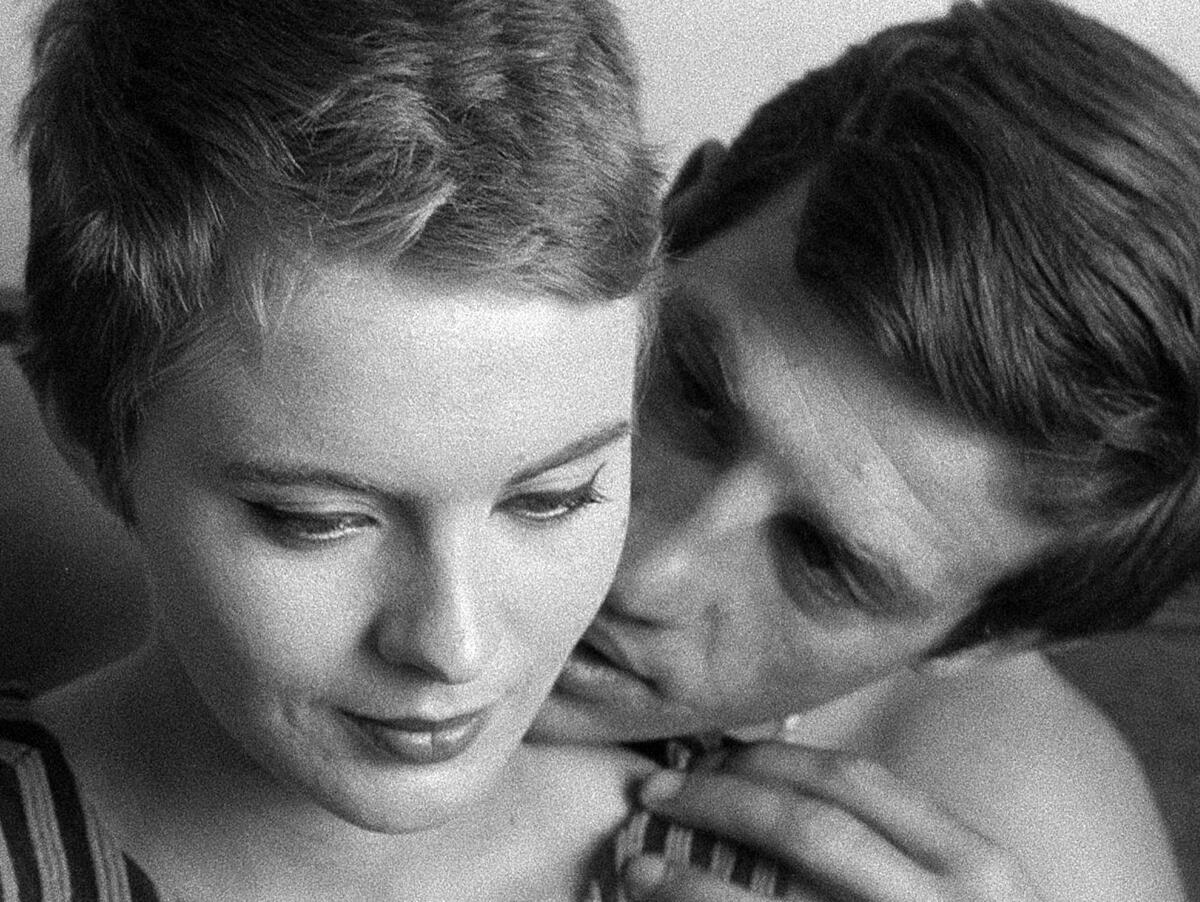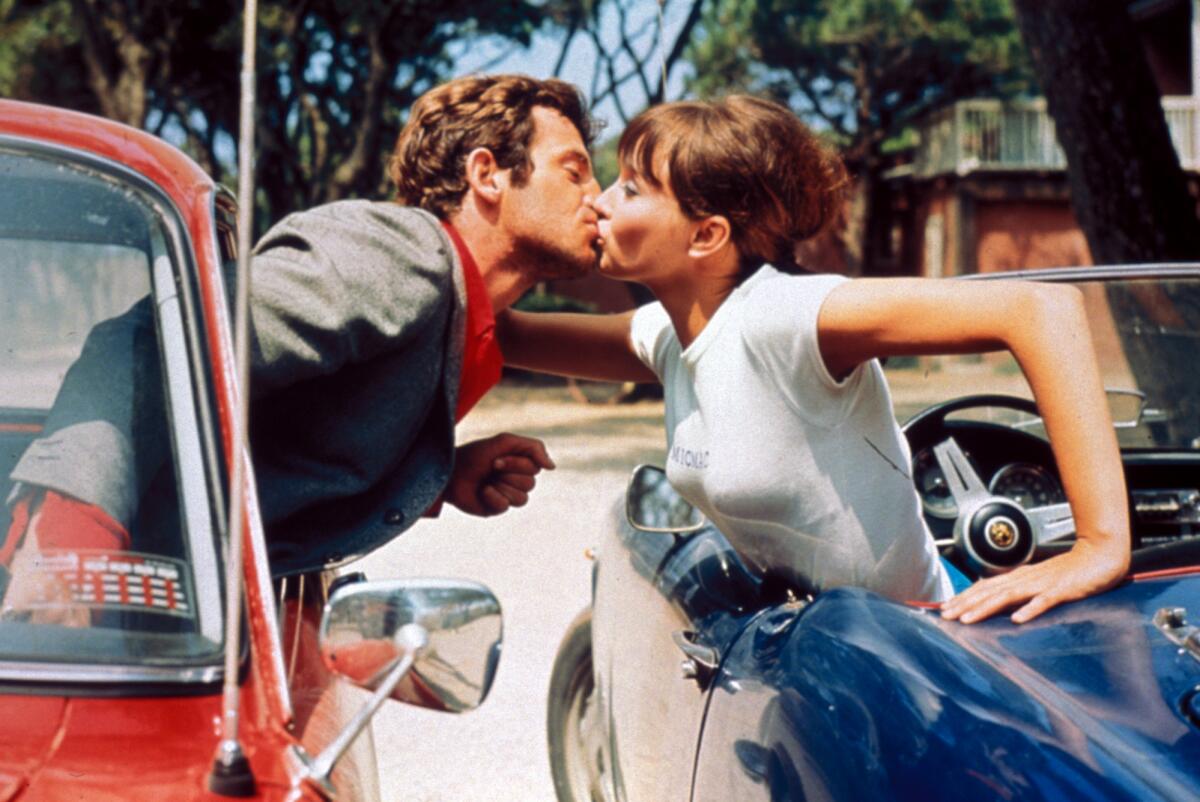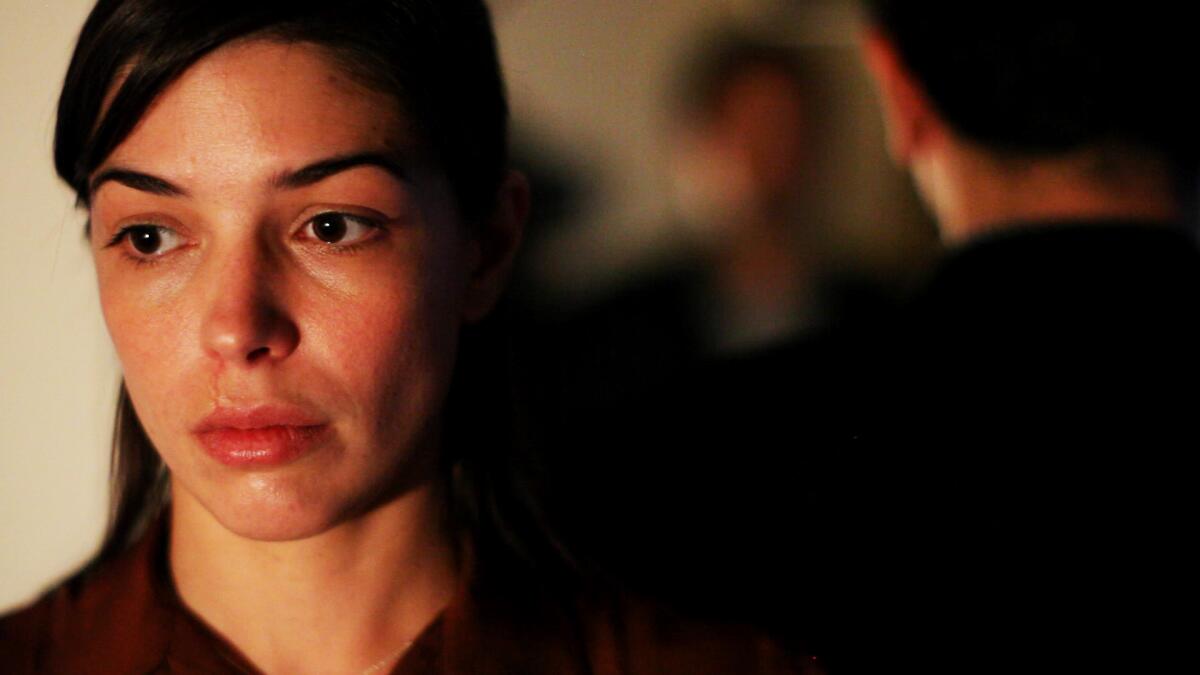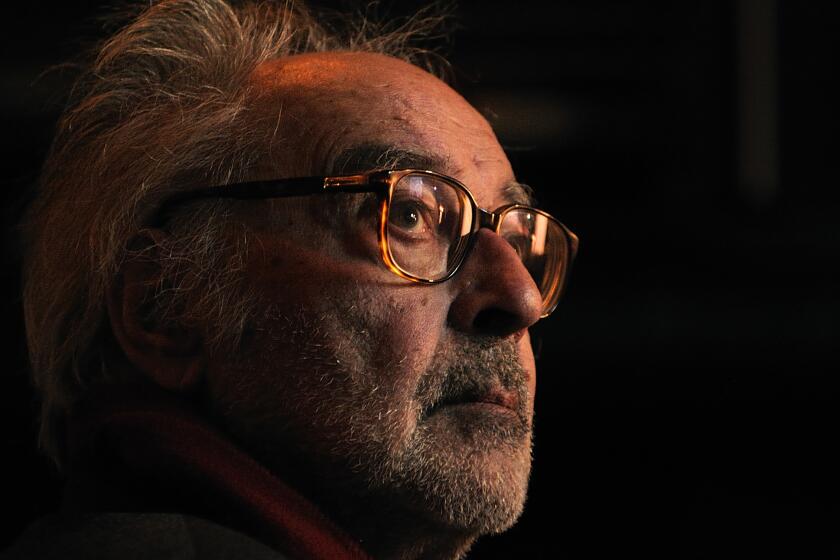If you’re overdue for an intro to Jean-Luc Godard, here are 6 films to start with

- Share via
The iconoclast at the epicenter of the French New Wave and one of film’s most influential makers, Jean-Luc Godard, who died Tuesday at 91, leaves behind a colossal legacy of more than 100 feature films, shorts and documentaries. Where to begin?
As a young critic for the magazine Cahiers du Cinéma in the 1950s, Godard and his contemporaries first challenged cinematic conventions in words. Then they reshaped the medium from behind the camera, as Godard did in his rebellious first feature, the Nouvelle Vague classic “Breathless” (1960). Through the end of the 1960s, the director produced a prolific body of now-iconic works, including “A Woman Is a Woman” (1961), “Contempt” (1963), “Band of Outsiders” (1964), “Alphaville” (1965), “Masculin Féminin” (1966), “Two or Three Things I Know About Her” (1967) and “Week-end” (1967).
Godard, who made such films as ‘Breathless’ and ‘Weekend,’ was widely viewed as the most inventive and radical of the French New Wave directors.
Later, Godard’s interrogations of cinematic possibilities became more engaged with radical French politics, such as 1972’s “Tout Va Bien,” starring Jane Fonda and co-directed with Jean-Pierre Gorin; unexpected artworks, like his 1987 adaptation of “King Lear”; and the essay form (more recent avant-garde films “Goodbye to Language” and “The Image Book,” his final feature). Some of Godard’s most celebrated films, like “Band of Outsiders,” are not currently available to stream. (Criterion has it on disc — vive le physical media!) But there are still plenty of options if your DVD/Blu-ray player is collecting dust.
In particular, the Criterion Channel has a nine-film tribute to Godard with titles such as “Le Petit Soldat” (1963) and “Every Man for Himself” (1980) and numerous interviews with Godard throughout his career.

Here are six features you can stream now to start your dive into the legendary filmmaker’s canon, and where to find them.
‘Breathless’ (1960)
Running time: 1 hour, 30 minutes.
Rating: Unrated.
Streaming: Amazon Prime: Rent/Buy | Apple TV+: Rent/Buy | HBO Max: Included | Vudu: Rent/Buy | Criterion: Included | Kanopy: Included
All you need to make a movie, Jean-Luc Godard famously proposed, is a girl and a gun, and he proved that formula the first time out of the box with his 1960 “Breathless,” the fatalistic romance that started a revolution.
Starring Jean-Paul Belmondo as a brash French hooligan and Jean Seberg as the American in Paris he loves against his better judgment, “Breathless” caused a sensation when it took its place as one of the first examples of what came to be known as la Nouvelle Vague, a.k.a. the French New Wave.
Godard and his New Wave confederates, such as Francois Truffaut (who wrote the “Breathless” treatment) and Jacques Rivette (who has a wordless cameo as a hit-and-run victim), were frustrated film critics (is there any other kind) who wanted to turn mainstream film upside down. (Read more) — Kenneth Turan
‘My Life to Live’ (Vivre sa vie) (1962)
Running time: 1 hour, 23 minutes.
Rating: TV-14.
Streaming: | HBO Max: Included | Kanopy: Included | Criterion: Included
As Times staff writer Mark Olsen wrote in his 2016 profile of the actor, Anna Karina’s “enigmatic mix of carefree insouciance, emotional transparency and chic style made her a good fit for Godard’s distinctive blend of spontaneity and precision” — and there may be no more formidable example than “Vivre Sa Vie.” Karina, who was married to Godard from 1961 to 1967, had already collaborated twice with the director, on “A Woman Is a Woman” and “Le Petit Soldat,” but it’s as Nana, a woman who abandons her family to pursue a career as an actress and ends up in a seedy world of sex work, that she emerged most forcefully as the “muse” of the New Wave — and exemplified the phrase “tragic beauty.” She also helped prove that Godard’s filmmaking prowess translated to a dramatic register as well as it did comedy or crime. —Matt Brennan
‘Pierrot le Fou’ (1965)
Running time: 1 hour, 51 minutes.
Rating: TV-14.
Streaming: Amazon Prime: Rent/Buy | Apple TV+: Rent/Buy | Vudu: Included
Jean-Luc Godard’s films have always reflected the times in which they were made with their acute, even startling ability to evoke self-recognition, yet so rich and far-ranging are their concerns that it is hardly surprising they seem timeless. Such is the case with the dazzling “Pierrot le Fou” (1965), which could just as easily be unfolding now instead of 42 years ago. It is best remembered for an appearance by director Samuel Fuller, playing himself as a party guest and famously defining cinema thus: “The film is a battleground: love, hate, action, violence, death — in one word, emotion.” “Pierrot le Fou” is all that plus intellect. (Read more) — Kevin Thomas

‘First Name: Carmen’ (1983)
Running time: 1 hour, 24 minutes.
Rating: Unrated.
Streaming: Kanopy: Included
In the violent farce “First Name: Carmen” (1983), written by Godard’s longtime partner and collaborator Anne-Marie Miéville,
Godard himself plays a director, confined to an institution while his niece (Maruschka Detmers) attempts a bank heist, only to fall for the cop who intervenes. Riffing on the various versions of “Carmen” (Merimee’s novella, Bizet’s opera, Otto Preminger’s movie), the film revisits the lovers-on-the-run scenario of “Pierrot le fou,” but in contrast to the earlier film’s doomy romanticism, the love story is exhausted before it barely begins, mired in ill feeling and impotence. (Read more) — Dennis Lim
‘Goodbye to Language’ (2014)
Running time: 1 hour, 9 minutes.
Rating: Unrated.
Streaming: Apple TV+: Rent/Buy | Kanopy: Included | Plex: Free
Disclaimer: Do not let reviews, including this one, discourage you in any way from seeing Jean-Luc Godard’s “Goodbye to Language 3D.” Yes, there is an air of forbidding obscurity to it, especially for anyone looking for more conventional storytelling, but the film is also exhilarating, rewarding and gives back many times over whatever effort and thought one invests into it. While top-shelf filmmakers such as Martin Scorsese, Werner Herzog, Wim Wenders and James Cameron have all made their own striking forays into the format, this is Godard’s first feature-length film made in 3-D, and there are images and moments here quite unlike any brought to screen before. Anyone interested in the possibilities of the moviegoing experience — what can happen in a dark theater — owes it to themselves to say hello to “Goodbye to Language.” (Read more) — Mark Olsen
‘The Image Book’ (2018)
Running time: 1 hour, 24 minutes.
Rating: Unrated.
Streaming: Kanopy: Included | Apple TV+: Rent/Buy | Plex: Free | Vudu: Rent/Buy
“The Image Book” is an 85-minute cinematic brainstorm, a swirling, dazzling, maddening frenzy of disconnected sights and sounds that have been compiled and arranged according to a rhythmic and rhetorical logic that only its maker can fully divine. That’s a roundabout way of saying it’s a new movie by Jean-Luc Godard, the 88-year-old Swiss-born filmmaker-philosopher-essayist still fondly remembered as one of the last standing pillars of the French New Wave.
It has, of course, been several decades and many more movies since the celluloid-era glories of “Breathless,” “Masculin Féminin” and “Weekend,” and these days Godard is more often appreciated — or not — as an endlessly elusive (and allusive) cine-crank, an artistic giant who has moved past radical experimentation into a realm of stubborn, gnomic inscrutability. (Read more) — Justin Chang
More to Read
Only good movies
Get the Indie Focus newsletter, Mark Olsen's weekly guide to the world of cinema.
You may occasionally receive promotional content from the Los Angeles Times.














